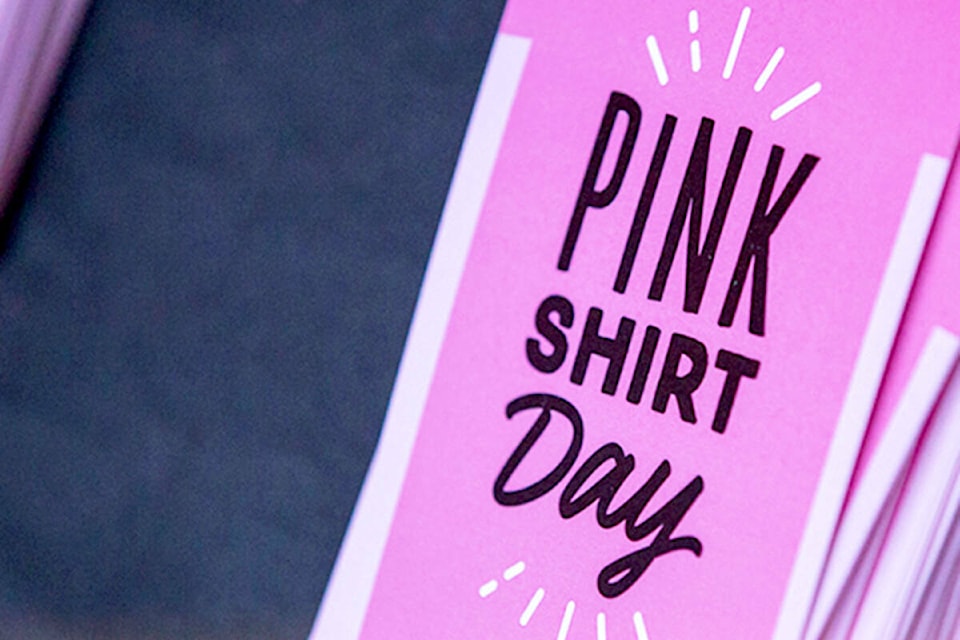It happens in the blink of an eye. One moment, you’re holding your freshly swaddled baby, hearing their coos for the first time, and the next, you’re wondering if they’ll be OK as you wave goodbye to them on their first day of kindergarten.
With the arrival of school, parents face a new set of challenges: the loss of control over their child’s circle of influence. While one does what one can to prepare their children for school, bullying is sadly a part of life. Thankfully, bullying can be prevented and stopped.
In 2007, Grade 12 students David Shepherd and Travis Price of Nova Scotia took matters into their own hands after a fellow Grade 9 student, Chuck McNeill, was bullied for wearing a pink polo shirt on the first day of school. Students began directing homophobic remarks at McNeill, which didn’t sit well with Shepherd or Price.
In an interview with the Canadian Museum for Human Rights, Price explained that he and Shepherd came up with the idea for their schoolmates to wear pink shirts as a way of standing up for the bullied student. He and Shepherd then went out and purchased 75 women’s tank tops and pink pre-wrap rolls to make headbands and wristbands.
Next, they contacted their school’s administration with their idea. The school warned the boys about possible fights that may break out and let them know that it was on them if expulsion occurred. Undeterred, Price thought, “this will be the best fight I’m ever going to fight.” He and Shepherd posted on MSN Messenger, an online instant messenger, asking students to join them in wearing pink shirts.
More than 750 students went to school the next day wearing pink shirts. In a school of 1,000, their power showed in numbers.
Price, who had also been bullied, saw McNeill as a kid like himself. As the older student, he was inspired to be a good leader and take a stand for younger students and others who experienced bullying. Little did Price and Shepherd know just how astronomical this event would become.
In 2007, before going viral was a thing, this is just what happened, as the following week, students not only in Nova Scotia but all across Canada began wearing pink shirts. Eventually, Pink Shirt Day was formed as an anti-bullying initiative. It takes place each year on the last Wednesday of February.
This year’s event is on Wednesday, Feb. 22.
Understanding Bullying
None of us has been untouched by bullying, whether we’ve been the bystander, the victim or the bully. With previous research suggesting one in five children have been bullied, Safe Canada estimates that around one in three children are bullied, with 47 per cent of parents in Canada having one of their children bullied.
This number is low. Over half of the victims do not report a bullying incident to a teacher, according to Canadian Red Cross.
Bullying is repeated hurtful actions towards a child, whether to their face or behind their back, that cause physical or psychological harm, making it increasingly difficult for the bullied child to cope. This includes things like name-calling, teasing, spreading rumours, gossiping, excluding others and making threats, as well as physically aggressive behaviour, such as shoving, hitting, kicking and punching.
Bullying happens where there is a power imbalance, where one child dominates over another, or so it may seem for the victimized child.
Aside from physical injuries, there are other signs children may display when bullied: low self-esteem, anxiety, depression, losing interest in activities they once enjoyed, isolating themselves, being hungry after school and dealing with stomach aches or headaches, to name a few.
Signs a child might be the perpetrator of bullying events include anger against others, witnessing aggression from other adults or older siblings, or children who have difficulties standing up for or empathizing with others.
This domination doesn’t only happen in the physical world either. Not only are children dealing with the effects of bullying at school but also in places where they should be safe, such as at home. With phones in so many of our children’s hands and pockets, cyberbullying occurs anywhere and everywhere.
Understanding Cyberbullying
Cyberbullying has the same psychological effects, where individuals use technology – such as social media, texting and emailing – to harass, threaten, exclude or humiliate someone.
Parents should be hyper-vigilant in ensuring their child’s online safety by monitoring their phone and online usage and teaching them how to be safe online. Below is a list of some of the cyberbullying behaviours:
Catfishing – creating a fake identity and then trying to get the victim to engage in a relationship with them
Cyberstalking – when a cyberbully monitors the victim’s computer activity and “follows” them online
Denigration/Dissing – spreading damaging information, rumours or gossip about an individual
Doxxing – sharing someone’s personal information online in order to harass them (such as their home address, where they go to school or their social security number)
Exclusion – leaving a child out of a group, such as a group text thread
Flaming – posting hateful content online about a victim in hopes of getting them to fight back
Fraping – accessing someone else’s social media account and posting harmful content in order to ruin their reputation
Impersonation – impersonating a victim by posting inappropriate things about them online
Trickery – tricking a victim into confiding their secrets with them, then publicly sharing the information
Trolling – posting rude or hateful comments online about an individual
Prevent bullying
According to the Pink Shirt Day website, “most bullying incidents stop within 10 seconds if a bystander intervenes.”
Many other resources are available for children, youth and adults, some of which can be found on the Pink Shirt Day website.
